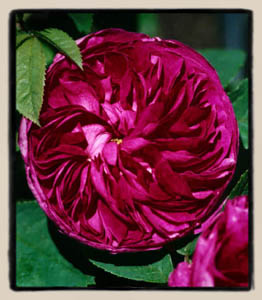 |
|
Albas |
Illustrated here at left is 'Charles de Mills' The Gallicas are one of the oldest and most highly evolved of all roses ever bred. They were often referred to as the "Mad Gallicas', which was a reference to their wild and intense coloring. There are even a few striped and spotted varieties in this class! From Brent Dickerson: "These are selections bred from the "French Rose," R. gallica. A Gallica will typically have a stocky plant, an open blossom which shows the stamens and is held upright, usually in colors varying on one side or the other from rose-red. Variations, however, are almost limitless as well as subtle, and all degrees of height and blossom may be found, from near singles to full doubles, from blush pinks to maroon, from clear homogeneous colors to cloudy, striped, and/or spotted blossoms. The plants are easily propagated by their runners or suckers when on their own roots." All of the Gallicas are once blooming roses. Some of them have a very brief bloom period of only 3 or 4 weeks in early summer, but many of them bloom for up to 6 weeks. Most of the Gallicas have very good fragrances, with a few exceptions. As garden shrubs, they are hard to beat! As a rule, they are graceful, well bahaved garden specimens, although some are a bit big for smaller gardens. Most of them are between 3 and 4 feet in height, and if grown on their own roots, can spread to form thickets. In smaller gardens, it is perhaps best to grow a grafted specimen, which will not sucker. Disease resistance is usually very good, the only problem being that they tend to get some mildew under cool and damp weather conditions. This is more of a cosmetic problem than it is a threat to the plant's health. The Gallicas are all very strong and cold hardy shrubs, suitable for growing in zones 4 -8a. Original photographs and site content © Paul Barden 2006, All Rights Reserved. |
|

